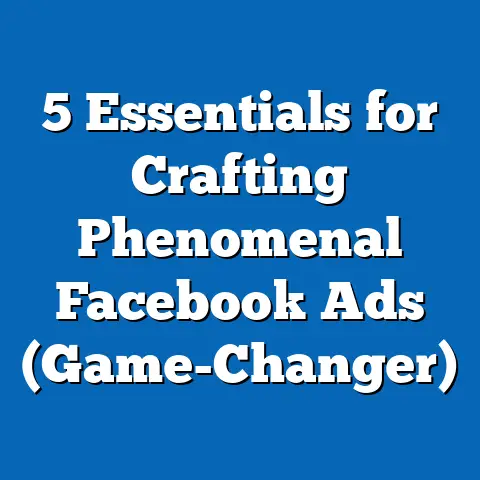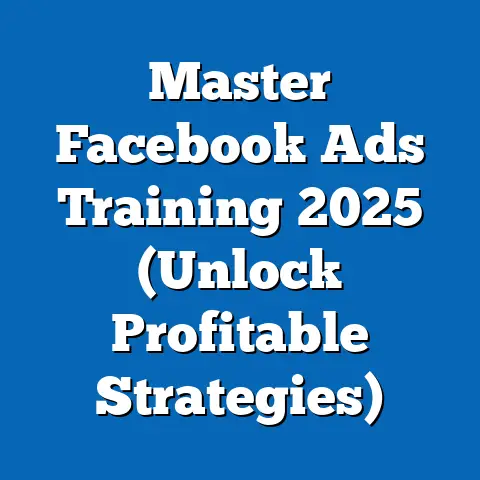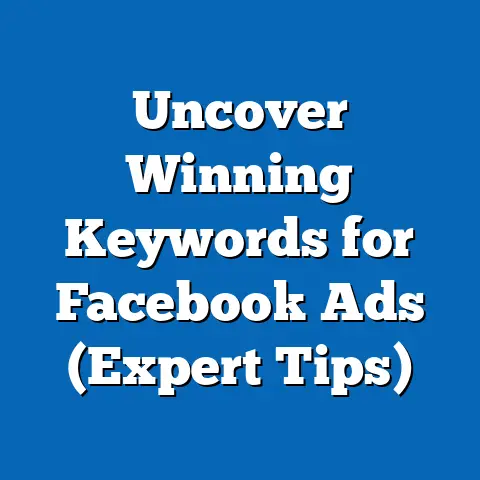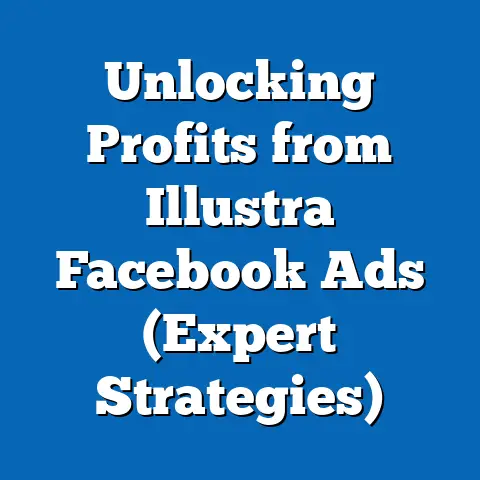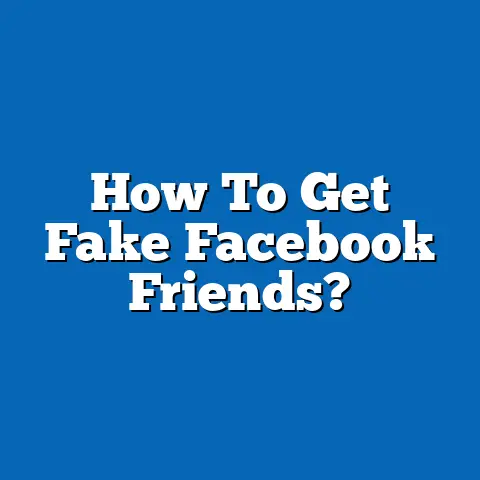Elevate Facebook Fashion Ads (Proven Strategies Revealed)
Fashion, darling, it’s not just about what you wear; it’s about how you present it to the world. And in today’s digital landscape, Facebook ads are your runway to a global audience. The fashion industry has exploded on social media, and Facebook sits at the epicenter, boasting billions of active users ready to be captivated by your brand’s unique style. For fashion brands, Facebook ads aren’t just an option; they’re a necessity. They offer an unparalleled opportunity to reach precisely targeted audiences, showcase your latest collections, and drive sales directly from the platform.
I’ve seen firsthand how a well-crafted Facebook ad campaign can transform a small boutique into a recognizable brand. I remember working with a local designer who was struggling to gain traction. We revamped her Facebook ads, focusing on stunning visuals and hyper-targeted audiences. Within months, her online sales skyrocketed, and she was able to open a second brick-and-mortar location. That’s the power of Facebook ads when done right.
But here’s the beauty of it: once you’ve laid the groundwork, Facebook ads can almost run themselves. Think of it as setting up a perfectly tailored outfit – once it fits just right, you barely have to fuss with it. This article is your guide to creating that perfectly tailored Facebook ad strategy. I’m going to show you how to build effective campaigns that require minimal ongoing maintenance while delivering consistent results.
Section 1: Understanding the Facebook Ads Ecosystem
Before we start designing our fabulous ad campaigns, let’s get acquainted with the Facebook Ads ecosystem. Think of it as your virtual fashion studio – a place where you can create, experiment, and showcase your designs to the world. Understanding the key components of this ecosystem is crucial for navigating the platform effectively and achieving your advertising goals.
Key Terminologies
- Ad Manager: This is your central command center for creating, managing, and tracking your Facebook ad campaigns. It’s where you’ll define your target audience, set your budget, design your ads, and analyze your performance. I always recommend familiarizing yourself with the Ad Manager interface before launching your first campaign.
- Audience Insights: This powerful tool allows you to gain valuable insights into your target audience’s demographics, interests, behaviors, and more. It helps you understand who your ideal customers are and what motivates them. I’ve used Audience Insights to uncover hidden interests that significantly improved my targeting.
- Facebook Pixel: This is a small piece of code that you install on your website. It tracks user actions, such as page views, add-to-carts, and purchases, allowing you to measure the effectiveness of your ads and optimize your campaigns for conversions. The Pixel is an absolute must-have for any fashion brand serious about driving sales through Facebook ads.
- Campaign, Ad Set, and Ad Structure: Facebook campaigns are structured in a hierarchical manner. A campaign contains one or more ad sets, and each ad set contains one or more ads. This structure allows you to organize your ads based on different targeting options, budgets, and creatives.
Advantages of Facebook Ads for Fashion Brands
- Targeting Capabilities: Facebook’s advanced targeting options allow you to reach specific fashion consumers based on demographics, interests, behaviors, and even purchase history. You can target people who are interested in specific fashion brands, styles, or trends.
- Analytics: Facebook Ads Manager provides detailed analytics on your ad performance, allowing you to track key metrics such as impressions, clicks, conversions, and return on ad spend (ROAS). This data helps you understand what’s working and what’s not, so you can optimize your campaigns for better results.
- Cost-Effectiveness: Compared to traditional advertising channels, Facebook ads can be incredibly cost-effective, especially for fashion brands. You can set your own budget and bid on ad placements, allowing you to control your spending and maximize your ROI.
- Visual Storytelling: Fashion is inherently visual, and Facebook provides the perfect platform for showcasing your brand’s unique style through stunning imagery and video content. You can create visually appealing ads that capture attention and convey your brand’s message effectively.
Case Studies: Fashion Brands Crushing It with Facebook Ads
- ASOS: This online fashion retailer has mastered the art of Facebook advertising by using highly targeted ads that showcase their latest collections and promotions. They leverage carousel ads to display multiple products and drive traffic to their website.
- Nordstrom: This department store chain uses Facebook ads to promote their seasonal sales and events, targeting customers based on their past purchases and browsing history. They use video ads to create a more immersive and engaging experience.
- Warby Parker: This eyewear brand uses Facebook ads to promote their home try-on program, targeting customers who are interested in buying glasses online. They use visually appealing ads that showcase their stylish frames and highlight the convenience of their service.
Takeaway: Understanding the Facebook Ads ecosystem is essential for creating effective and efficient fashion ad campaigns. By familiarizing yourself with the key terminologies, advantages, and case studies, you’ll be well-equipped to navigate the platform and achieve your advertising goals. Next, we’ll dive into defining your target audience, which is the cornerstone of any successful Facebook ad campaign.
Section 2: Defining Your Target Audience
Imagine trying to sell a winter coat in the middle of summer in Miami. It’s not going to work, right? The same principle applies to Facebook ads. You need to target the right audience to maximize your chances of success. In the fashion niche, audience segmentation is crucial. You can’t just target everyone who wears clothes; you need to identify your ideal customers and tailor your ads to their specific needs and preferences.
Audience Types
- Demographics: This includes basic information such as age, gender, location, education, and income. For example, if you’re selling luxury handbags, you’ll want to target women aged 25-54 with a higher income level.
- Interests: This includes things that people are passionate about, such as fashion brands, styles, hobbies, and activities. For example, if you’re selling sustainable clothing, you’ll want to target people who are interested in eco-friendly products and ethical fashion.
- Behaviors: This includes people’s online and offline actions, such as purchase history, website visits, and engagement with Facebook pages. For example, if you’re selling athletic wear, you’ll want to target people who have recently purchased sports equipment or visited fitness websites.
- Custom Audiences: These are audiences that you create based on your own data, such as customer lists, website visitors, and app users. Custom audiences allow you to target people who have already interacted with your brand, making them more likely to convert. I’ve found that uploading customer email lists and creating lookalike audiences based on them can be incredibly effective.
- Lookalike Audiences: These are audiences that Facebook creates based on your existing custom audiences. Facebook identifies people who share similar characteristics and behaviors with your best customers, allowing you to expand your reach and find new potential customers.
Creating Buyer Personas
A buyer persona is a fictional representation of your ideal customer. It’s based on research and data about your existing customers and target audience. Creating buyer personas helps you understand your customers’ needs, motivations, and pain points, allowing you to tailor your ads to their specific interests.
For example, let’s say you’re selling bohemian-style clothing. Your buyer persona might be “Free-Spirited Fiona,” a 28-year-old woman who loves traveling, yoga, and expressing her individuality through her clothing. She values comfort, sustainability, and unique designs.
Strategies for Using Facebook’s Targeting Tools
- Layering Targeting Options: Don’t just rely on one targeting option. Layer multiple targeting options to narrow down your audience and reach the most relevant people. For example, you could target women aged 25-34 who are interested in fashion, travel, and bohemian style.
- Using Detailed Targeting Expansion: This feature allows Facebook to expand your targeting beyond your initial audience if it believes it can find more people who are likely to convert. I recommend testing this feature to see if it improves your campaign performance.
- Excluding Audiences: Don’t forget to exclude audiences that are not relevant to your business. For example, if you’re selling high-end fashion, you might want to exclude people who are interested in discount clothing stores.
- Testing Different Audiences: Don’t be afraid to experiment with different audiences to see what works best. Create multiple ad sets with different targeting options and track their performance to identify the most profitable audiences.
Tips for Conducting Audience Research
- Facebook Audience Insights: Use this tool to gain insights into your target audience’s demographics, interests, behaviors, and more.
- Customer Surveys: Ask your existing customers about their interests, preferences, and shopping habits.
- Website Analytics: Analyze your website traffic to see who is visiting your site and what they are looking for.
- Social Media Listening: Monitor social media conversations to see what people are saying about your brand and your competitors.
Takeaway: Defining your target audience is crucial for creating effective Facebook ad campaigns. By understanding your customers’ demographics, interests, and behaviors, you can tailor your ads to their specific needs and preferences, increasing your chances of success. Next, we’ll explore how to craft compelling ad creative that captures attention and drives conversions.
Section 3: Crafting Compelling Ad Creative
You’ve defined your target audience, now what? It’s time to create ad creative that grabs their attention and makes them want to learn more about your brand. In the fashion niche, visuals are king. High-quality imagery and video content are essential for capturing attention and conveying your brand’s unique style. But it’s not just about the visuals; your ad copy and call-to-action (CTA) also play a crucial role in driving conversions.
Elements of Effective Ad Creative
- Visuals: Use high-quality images and videos that showcase your products in the best possible light. Make sure your visuals are well-lit, in focus, and visually appealing. Consider using lifestyle shots that show your products being worn or used in real-life settings. I’ve found that showcasing diverse models and body types can significantly improve engagement.
- Copy: Write clear, concise, and compelling ad copy that highlights the benefits of your products and speaks to your target audience’s needs and desires. Use strong verbs and persuasive language to encourage clicks and conversions.
- Call-to-Action (CTA): Include a clear and concise CTA that tells people what you want them to do, such as “Shop Now,” “Learn More,” or “Get 20% Off.” Make sure your CTA is visually prominent and easy to click.
The Importance of High-Quality Imagery and Video Content
- Captures Attention: In today’s fast-paced digital world, you have only a few seconds to grab someone’s attention. High-quality visuals can help you stand out from the crowd and make a lasting impression.
- Conveys Brand Identity: Your visuals should reflect your brand’s unique style and personality. Use consistent colors, fonts, and imagery to create a cohesive brand identity.
- Showcases Products: Your visuals should showcase your products in the best possible light, highlighting their features and benefits.
- Creates Emotional Connection: Visuals can evoke emotions and create a connection with your target audience. Use imagery and video that resonates with their values and aspirations.
Examples of Successful Fashion Ad Creatives
- Everlane: This clothing brand uses simple, clean visuals that showcase their minimalist designs and sustainable materials. Their ad copy is straightforward and highlights the quality and affordability of their products.
- Reformation: This clothing brand uses visually stunning imagery that showcases their trendy designs and eco-friendly practices. Their ad copy is witty and engaging, appealing to their target audience of fashion-conscious millennials.
- Nike: This athletic wear brand uses dynamic video ads that showcase their products in action. Their ad copy is inspirational and motivational, encouraging people to push their limits and achieve their goals.
Tips on A/B Testing Different Creatives
- Test One Element at a Time: When A/B testing your ad creatives, make sure to test only one element at a time, such as the headline, image, or CTA. This will allow you to accurately measure the impact of each element on your campaign performance.
- Use a Control Group: Create a control group that receives your original ad creative. This will serve as a benchmark against which you can compare the performance of your new ad creatives.
- Track Key Metrics: Track key metrics such as impressions, clicks, conversions, and cost per acquisition (CPA) to see which ad creatives are performing best.
- Iterate and Optimize: Based on your A/B testing results, iterate and optimize your ad creatives to improve their performance.
Takeaway: Compelling ad creative is essential for capturing attention and driving conversions. By using high-quality visuals, writing clear and concise ad copy, and including a strong CTA, you can create ads that resonate with your target audience and achieve your advertising goals. Next, we’ll explore the various Facebook ad formats and how to leverage them for your fashion brand.
Section 4: Leveraging Facebook Ad Formats
Facebook offers a variety of ad formats, each with its own unique benefits and use cases. Choosing the right ad format for your fashion brand depends on your goals, budget, and target audience. Let’s dive into the most popular ad formats and how to leverage them effectively.
Carousel Ads
Carousel ads allow you to showcase multiple images or videos in a single ad. Each image or video has its own headline, description, and CTA, allowing you to highlight different products, features, or benefits.
- Benefits:
- Showcase multiple products in a single ad
- Tell a story through a series of images or videos
- Drive traffic to different pages on your website
- Use Cases:
- Highlighting a collection of new arrivals
- Showcasing different styles or colors of a product
- Telling the story behind your brand
- Example: A clothing brand uses a carousel ad to showcase their new summer collection, with each image featuring a different outfit and a link to the product page.
- Showcase multiple products in a single ad
- Tell a story through a series of images or videos
- Drive traffic to different pages on your website
- Highlighting a collection of new arrivals
- Showcasing different styles or colors of a product
- Telling the story behind your brand
Slideshow Ads
Slideshow ads allow you to create a video-like experience using a series of images or videos. These ads are perfect for brands that don’t have the budget or resources to create high-quality video content.
- Benefits:
- Create a video-like experience without the need for video production
- Easy to create and manage
- Engaging and visually appealing
- Use Cases:
- Showcasing a product’s features and benefits
- Creating a behind-the-scenes look at your brand
- Highlighting customer testimonials
- Example: A jewelry brand uses a slideshow ad to showcase their handcrafted pieces, with each image featuring a close-up shot of the jewelry and a description of the materials and craftsmanship.
- Create a video-like experience without the need for video production
- Easy to create and manage
- Engaging and visually appealing
- Showcasing a product’s features and benefits
- Creating a behind-the-scenes look at your brand
- Highlighting customer testimonials
Video Ads
Video ads are one of the most engaging and effective ad formats on Facebook. They allow you to tell a story, showcase your products in action, and connect with your target audience on an emotional level.
- Benefits:
- Highly engaging and visually appealing
- Effective for storytelling and brand building
- Can drive significant traffic and conversions
- Use Cases:
- Showcasing your products in action
- Creating a behind-the-scenes look at your brand
- Highlighting customer testimonials
- Example: A shoe brand uses a video ad to showcase their latest running shoes, with athletes wearing the shoes and running in various terrains.
- Highly engaging and visually appealing
- Effective for storytelling and brand building
- Can drive significant traffic and conversions
- Showcasing your products in action
- Creating a behind-the-scenes look at your brand
- Highlighting customer testimonials
Collection Ads
Collection ads allow you to showcase your products in a visually appealing and immersive format. These ads feature a main image or video along with several smaller product images, making it easy for people to browse and discover your products.
- Benefits:
- Visually appealing and immersive
- Easy for people to browse and discover your products
- Can drive significant traffic and conversions
- Use Cases:
- Showcasing a collection of new arrivals
- Highlighting different categories of products
- Promoting seasonal sales and events
- Example: A beauty brand uses a collection ad to showcase their new makeup collection, with a main image featuring a model wearing the makeup and smaller images featuring individual products.
- Visually appealing and immersive
- Easy for people to browse and discover your products
- Can drive significant traffic and conversions
- Showcasing a collection of new arrivals
- Highlighting different categories of products
- Promoting seasonal sales and events
Stories Ads
Stories ads are full-screen, vertical ads that appear in Facebook Stories. These ads are perfect for capturing attention and driving engagement in a mobile-first environment.
- Benefits:
- Full-screen and immersive
- Highly engaging and visually appealing
- Perfect for mobile-first audiences
- Use Cases:
- Promoting limited-time offers and discounts
- Showcasing new products and collections
- Driving traffic to your website or app
- Full-screen and immersive
- Highly engaging and visually appealing
- Perfect for mobile-first audiences
- Promoting limited-time offers and discounts
- Showcasing new products and collections
- Driving traffic to your website or app
Takeaway: Facebook offers a variety of ad formats, each with its own unique benefits and use cases. By understanding the different ad formats and how to leverage them effectively, you can create engaging and visually appealing ads that resonate with your target audience and achieve your advertising goals. Next, we’ll explore how to set a budget and choose the right bidding strategy for your Facebook ads.
Section 5: Budgeting and Bidding Strategies
Let’s talk money, honey! Setting a budget and choosing the right bidding strategy for your Facebook ads is crucial for maximizing your ROI. You don’t want to spend all your money on ads that aren’t performing well, but you also don’t want to underspend and miss out on potential customers.
Setting a Budget
- Start Small: If you’re new to Facebook advertising, start with a small budget and gradually increase it as you see positive results. I recommend starting with a daily budget of $5-$10 per ad set.
- Consider Your Goals: Your budget should be aligned with your advertising goals. If you’re trying to drive brand awareness, you might be willing to spend more per impression than if you’re trying to drive sales.
- Calculate Your Customer Lifetime Value (CLTV): Understanding your CLTV can help you determine how much you’re willing to spend to acquire a new customer.
- Use a Budgeting Tool: Facebook offers a budgeting tool that can help you estimate your potential reach and results based on your budget and targeting options.
Bidding Strategies
- Cost Per Click (CPC): With CPC bidding, you pay each time someone clicks on your ad. This is a good option if you’re trying to drive traffic to your website.
- Cost Per Impression (CPM): With CPM bidding, you pay for every 1,000 impressions your ad receives. This is a good option if you’re trying to build brand awareness.
- Cost Per Acquisition (CPA): With CPA bidding, you pay each time someone takes a desired action, such as making a purchase or signing up for a newsletter. This is a good option if you’re trying to drive conversions.
- Return on Ad Spend (ROAS): ROAS measures the revenue you generate for every dollar you spend on advertising. This is a key metric for evaluating the effectiveness of your Facebook ad campaigns.
Monitoring Ad Performance and Adjusting Budgets
- Track Key Metrics: Track key metrics such as impressions, clicks, conversions, ROAS, and cost per acquisition (CPA) to see how your ads are performing.
- Use Facebook Ads Manager: Facebook Ads Manager provides detailed analytics on your ad performance, allowing you to identify what’s working and what’s not.
- Adjust Your Budget Based on Performance: If you see that an ad set is performing well, increase your budget to reach more people. If you see that an ad set is not performing well, decrease your budget or pause the ad set.
- A/B Test Different Bidding Strategies: Experiment with different bidding strategies to see which one works best for your business.
Takeaway: Setting a budget and choosing the right bidding strategy are crucial for maximizing your ROI on Facebook ads. By understanding your goals, calculating your customer lifetime value, and monitoring your ad performance, you can make informed decisions about your budget and bidding strategy. Next, we’ll explore how to analyze and optimize your campaign performance for better results.
Section 6: Analyzing and Optimizing Campaign Performance
You’ve launched your Facebook ad campaigns, but the work doesn’t stop there. Analyzing and optimizing your campaign performance is essential for achieving your advertising goals and maximizing your ROI. Think of it as fine-tuning your runway walk – you need to constantly adjust your posture, stride, and expression to captivate the audience.
Tracking Key Performance Indicators (KPIs)
- Impressions: The number of times your ad is displayed to your target audience.
- Reach: The number of unique people who saw your ad.
- Clicks: The number of times people clicked on your ad.
- Click-Through Rate (CTR): The percentage of people who saw your ad and clicked on it.
- Conversions: The number of people who took a desired action after clicking on your ad, such as making a purchase or signing up for a newsletter.
- Cost Per Acquisition (CPA): The cost of acquiring a new customer through your Facebook ad campaigns.
- Return on Ad Spend (ROAS): The revenue you generate for every dollar you spend on advertising.
Interpreting Analytics Data from Facebook Ads Manager
- Identify Trends: Look for trends in your data to see what’s working and what’s not. For example, are certain ad sets performing better than others? Are certain demographics more likely to convert?
- Segment Your Data: Segment your data by demographics, interests, behaviors, and ad placements to gain deeper insights into your audience and campaign performance.
- Use Visualizations: Use charts and graphs to visualize your data and identify patterns. Facebook Ads Manager offers a variety of visualizations that can help you understand your campaign performance.
Making Data-Driven Decisions to Optimize Campaigns
- Optimize Targeting: Based on your analytics data, refine your targeting options to reach the most relevant people.
- Optimize Ad Creative: Based on your A/B testing results, optimize your ad creatives to improve their performance.
- Optimize Bidding Strategy: Experiment with different bidding strategies to see which one works best for your business.
- Optimize Ad Placements: Test different ad placements to see which ones are most effective for reaching your target audience.
- Pause Underperforming Ad Sets: If you see that an ad set is not performing well, pause it and reallocate your budget to more profitable ad sets.
Metrics Like Click-Through Rates (CTR) and Conversion Rates
- Click-Through Rate (CTR): A high CTR indicates that your ad is relevant and engaging to your target audience. A low CTR indicates that your ad is not resonating with your audience, and you need to optimize your ad creative or targeting options.
- Conversion Rate: A high conversion rate indicates that your ad is effective at driving desired actions, such as purchases or sign-ups. A low conversion rate indicates that your landing page is not optimized for conversions, and you need to improve your website design and user experience.
Takeaway: Analyzing and optimizing your campaign performance is essential for achieving your advertising goals and maximizing your ROI. By tracking key metrics, interpreting analytics data, and making data-driven decisions, you can continuously improve your Facebook ad campaigns and drive better results.
Conclusion
We’ve journeyed through the world of Facebook fashion ads, uncovering the secrets to creating campaigns that not only capture attention but also deliver sustained results. From understanding the Facebook Ads ecosystem to crafting compelling ad creatives, leveraging different ad formats, setting a budget, and analyzing campaign performance, you now have the tools and knowledge to elevate your Facebook fashion ads to new heights.
Remember, the key to success lies in understanding your target audience, creating visually stunning ad creatives, and continuously optimizing your campaigns based on data. And here’s the best part: once you’ve set up your campaigns correctly, they can almost run themselves. Think of it as building a well-oiled machine – once it’s up and running, it requires minimal maintenance to keep it going strong.
I’ve seen countless fashion brands transform their businesses with Facebook ads. It’s not just about selling clothes; it’s about building a brand, connecting with your audience, and creating a community. And with the strategies I’ve shared in this guide, you can achieve all of that and more.
So, what are you waiting for? It’s time to take action and implement these proven strategies to elevate your Facebook fashion ads and drive sales. Don’t be afraid to experiment, test new ideas, and continuously optimize your campaigns. The fashion industry is constantly evolving, and your Facebook ad strategy should evolve with it.
Here’s your call to action:
- Define your target audience: Use Facebook Audience Insights to gain a deeper understanding of your ideal customers.
- Craft compelling ad creatives: Use high-quality visuals and persuasive ad copy that speaks to your target audience’s needs and desires.
- Leverage different ad formats: Experiment with carousel ads, slideshow ads, video ads, and collection ads to see which ones work best for your business.
- Set a budget and choose the right bidding strategy: Start small and gradually increase your budget as you see positive results.
- Analyze and optimize your campaign performance: Track key metrics and make data-driven decisions to continuously improve your Facebook ad campaigns.
By following these steps, you can create Facebook fashion ads that not only capture attention but also deliver sustained results with minimal ongoing maintenance. So, go ahead, unleash your creativity, and let your fashion brand shine on Facebook! The world is waiting to see what you’ve got. Now, go out there and make it happen!


